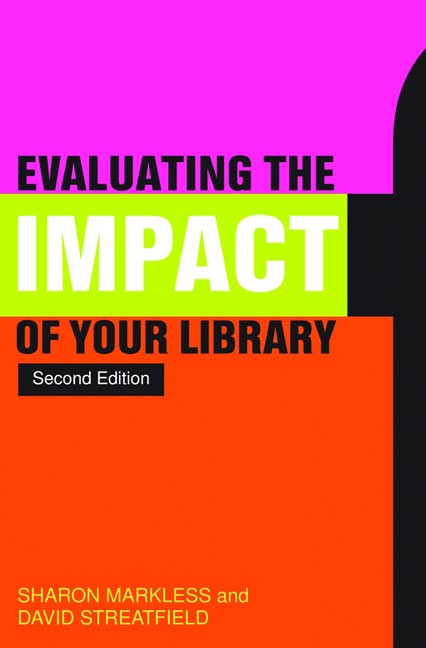Book contents
- Frontmatter
- Dedication
- Contents
- Introduction
- About the authors
- Impact and all that: use of some key terms in this book
- Part 1 The Context
- Part 2 Evaluating Impact
- 4 Putting the impact into planning
- 5 Getting things clear: objectives
- 6 Success criteria and impact indicators: how you know you are making a difference
- 7 Making things happen: activities and process indicators
- 8 Thinking about evidence
- 9 Gathering and interpreting evidence
- 10 Taking stock, setting targets and development planning
- Part 3 The Bigger Picture
- References
- Notes
- Index
- Evaluating and Measuring the Value, Use and Impact of Digital Collections
- Measuring Library Performance
- Miscellaneous Endmatter
9 - Gathering and interpreting evidence
from Part 2 - Evaluating Impact
Published online by Cambridge University Press: 08 June 2018
- Frontmatter
- Dedication
- Contents
- Introduction
- About the authors
- Impact and all that: use of some key terms in this book
- Part 1 The Context
- Part 2 Evaluating Impact
- 4 Putting the impact into planning
- 5 Getting things clear: objectives
- 6 Success criteria and impact indicators: how you know you are making a difference
- 7 Making things happen: activities and process indicators
- 8 Thinking about evidence
- 9 Gathering and interpreting evidence
- 10 Taking stock, setting targets and development planning
- Part 3 The Bigger Picture
- References
- Notes
- Index
- Evaluating and Measuring the Value, Use and Impact of Digital Collections
- Measuring Library Performance
- Miscellaneous Endmatter
Summary
This chapter suggests which evidence-gathering methods will tell you what you need to know, how to gather that evidence, and what that evidence is telling you. We then offer a warning about confusing evidence with advocacy.
Since it is probably better to adapt a research tool (such as a questionnaire, checklist or observation schedule) for your own purposes rather than start from scratch, we have prepared or selected a range of research tools for use in different types of libraries. These tools can be found at www.facetpublishing.co.uk/evaluatingimpact.
Let us start with a precept: all evidence-gathering methods have inherent weaknesses, so it is important to employ a range of methods if you want to build up a good picture – this is known in the research jargon as triangulation. Even if you are adapting an existing research tool there are a number of things that you should bear in mind when using them to gather evidence. These are considered below.
Observation
At first sight, it is surprising that library and information research borrows heavily on two of the social science research approaches (asking questions and making inferences) but largely neglects systematic observation as a research method. It is easy to understand this under-use in large-scale research, since systematic observation is time-consuming and can generate huge amounts of data. However, even when people take on small-scale evaluation they usually gravitate towards the questionnaire and the focus group, almost regardless of whether these will provide the sorts of information required.
This is a pity, because in the immortal words of the American baseball player and coach Lawrence ‘Yogi’ Berra, ‘You can observe a lot by watching.’ We know from our own experience that observation is a great way to develop ideas about how people use information, how library systems and services can be improved or how people can improve their teaching, training or interaction with service users. It is also one of the best ways of finding out whether your services are really making an impact.
There are several types of observation that may prove useful in evaluating the impact of your services.
Small-scale systematic observation
If you are interested in specific aspects of service use, such as how users find things in your library, or what they actually use your computers or wireless links for, a time-series study may be the answer.
- Type
- Chapter
- Information
- Evaluating the Impact of Your Library , pp. 127 - 170Publisher: FacetPrint publication year: 2012



